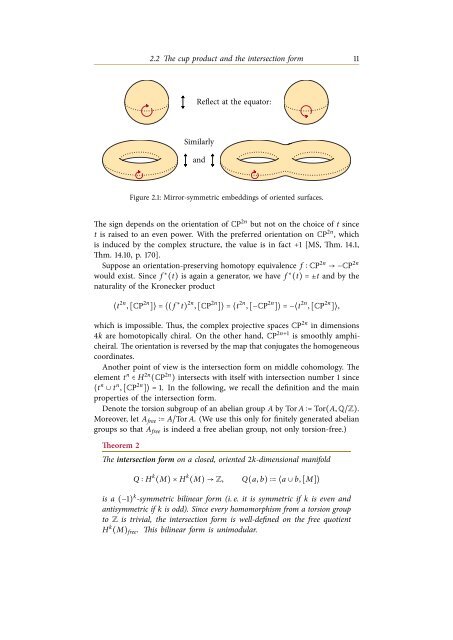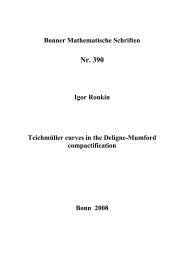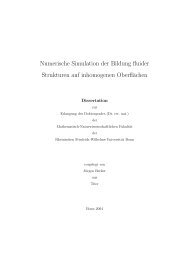Orientation reversal of manifolds - Universität Bonn
Orientation reversal of manifolds - Universität Bonn
Orientation reversal of manifolds - Universität Bonn
Create successful ePaper yourself
Turn your PDF publications into a flip-book with our unique Google optimized e-Paper software.
2.2 The cup product and the intersection form 11<br />
Reflect at the equator:<br />
Similarly<br />
and<br />
Figure 2.1: Mirror-symmetric embeddings <strong>of</strong> oriented surfaces.<br />
The sign depends on the orientation <strong>of</strong> CP 2n but not on the choice <strong>of</strong> t since<br />
t is raised to an even power. With the preferred orientation on CP 2n , which<br />
is induced by the complex structure, the value is in fact +1 [MS, Thm. 14.1,<br />
Thm. 14.10, p. 170].<br />
Suppose an orientation-preserving homotopy equivalence f ∶ CP 2n → −CP 2n<br />
would exist. Since f ∗ (t) is again a generator, we have f ∗ (t) = ±t and by the<br />
naturality <strong>of</strong> the Kronecker product<br />
⟨t 2n , [CP 2n ]⟩ = ⟨( f ∗ t) 2n , [CP 2n ]⟩ = ⟨t 2n , [−CP 2n ]⟩ = −⟨t 2n , [CP 2n ]⟩,<br />
which is impossible. Thus, the complex projective spaces CP 2n in dimensions<br />
4k are homotopically chiral. On the other hand, CP 2n+1 is smoothly amphicheiral.<br />
The orientation is reversed by the map that conjugates the homogeneous<br />
coordinates.<br />
Another point <strong>of</strong> view is the intersection form on middle cohomology. The<br />
element t n ∈ H 2n (CP 2n ) intersects with itself with intersection number 1 since<br />
⟨t n ∪ t n , [CP 2n ]⟩ = 1. In the following, we recall the definition and the main<br />
properties <strong>of</strong> the intersection form.<br />
Denote the torsion subgroup <strong>of</strong> an abelian group A by Tor A ∶= Tor(A, Q/Z).<br />
Moreover, let A free ∶= A/Tor A. (We use this only for finitely generated abelian<br />
groups so that A free is indeed a free abelian group, not only torsion-free.)<br />
Theorem 2<br />
The intersection form on a closed, oriented 2k-dimensional manifold<br />
Q ∶ H k (M) × H k (M) → Z,<br />
Q(a, b) ∶= ⟨a ∪ b, [M]⟩<br />
is a (−1) k -symmetric bilinear form (i. e. it is symmetric if k is even and<br />
antisymmetric if k is odd). Since every homomorphism from a torsion group<br />
to Z is trivial, the intersection form is well-defined on the free quotient<br />
H k (M) free . This bilinear form is unimodular.





